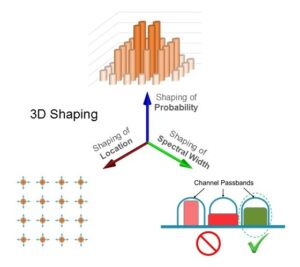Legacy carrier long-haul and metro optical networks were designed to take advantage of on-off-keyed (OOK) DWDM transmission using 50 or 100GHz grid spacing while maximizing both capacity and add/drop capabilities. Reconfigurable optical add/drop multiplexers (ROADMs) were also introduced to increase wavelength routing flexibility between sites. The significant impact from the growth of social media, high-definition streaming video, IoT, and a multitude of other bandwidth consuming applications have pushed the operators of these networks to adopt high-capacity coherent optical transmission technology.
Coherent transmission w/ varying baud rates and modulation modes applicable to multiple types of networks has been referred to as multi-haul, as described in the OFC 2018 Show Report. A ROADM-rich network design is typically attributed to traditional metro networks. However, with the rise of multi-haul capable coherent technology, the lines between what is considered metro and long haul are sometimes blurred. A previous blog post provided a brief tutorial of coherent optical communications and how it is applied to long-haul, DCI, and metro networks. I encourage you to read that post as it provides a good background for this blog post.
A benefit of coherent optical transmission is that the bandwidth capacity of a link can be increased by moving to a higher modulation order (e.g, from 2-bits/symbol QPSK to 4-bits/symbol 16QAM), as long as there is sufficient optical signal-to-noise ratio (OSNR) margin to overcome the resulting penalty. Acacia’s patented Fractional QAM (F-QAM) provides a higher level of granularity compared to traditional quantized integer-bits/symbol modulation orders, by enabling non-integer bits-per-symbol (e.g, 3.3 bits/symbol) modulation, to better optimize link capacity. Another adjustable “knob” to increase capacity is the transmission baud rate, which directly varies the spectral width of the signal. Similar to traditional quantized modulation orders, coherent technology has previously implemented quantized baud rates. However, these quantized baud rates may result in sub-optimal use of the available channel bandwidth—that is, the spectral width of the transmission does not fill up the channel’s available passband. Adaptive Baud Rate provides the granularity to enable increased optimization of the available passband. F-QAM and Adaptive Baud Rate are elements of the Acacia AC1200 coherent transponder module’s 3D shaping capability.
In a multi-haul network where optical transmission between end points may encounter numerous cascaded optical filters, one challenge is to spectrally optimize the optical transmission to fit within the aggregate passband of these filters from either fixed or reconfigurable add/drops of the network’s line system, as shown in Figure 1.

Figure 1. Spectrally quantized transmission may leave spectral gaps in aggregate passband.
As previously mentioned, quantized baud rates may not allow enough flexibility and granularity to fill up the passband. However, by using Adaptive Baud Rate, the capacity can be increased to more closely match the available spectrum within the aggregate passband of the cascaded filters with fine granularity, as shown in Figure 2.

Figure 2. Acacia’s Adaptive Baud Rate can optimize the spectral transmission to more closely match the available aggregate passband spectrum.
The aggregate passband of the cascaded filters contributes to the upper bound limit of capacity increase one can achieve in a multi-haul network optical link. In this case, I am not referring to the theoretical Shannon Limit. Rather, I am referring to the practical passband constraints that come from the implementation in a network of cascaded imperfect optical filter passbands due to variations of the filter conditions. Variations may become more prevalent if the optical transmission passes through a multi-vendor line system environment, a potential situation in a disaggregated network architecture. Having the ability to vary modulation and baud rate allows for maximal flexibility in optimizing the transmission to more closely match the line system’s available passband, as opposed to matching the line system to the terminal equipment’s optical characteristics.
As previously mentioned, Acacia’s 3D Shaping capability, as illustrated in Figure 3, enables the “dialing-in” of both modulation mode and baud rate.

Figure 3. Acacia’s 3D shaping capability enables optimization of link capacity and reach; shaping of spectral width is achieved using Adaptive Baud Rate.
This capability equates to the ability of the optical transmission spectrally “molding itself” to the line system’s passband on a link-by-link basis. By using 3D Shaping, to a certain extent the coherent DWDM source can be decoupled from the line system since the optical transmission is optimized regardless of the pass band characteristics of the line system. This capability lends itself nicely to the disaggregation of terminal equipment and line systems.
Whether multi-haul networks use flexible ROADM architectures with flexible passbands or architectures with fixed grid spacing (50GHz, 75GHz, 100GHz), the AC1200 with 3D Shaping can be used to optimize capacity with any of these type of line systems.
